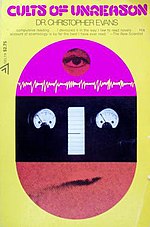Cults of Unreason
 1974 ed. Book cover | |
| Author | Dr. Christopher Riche Evans |
|---|---|
| Cover artist | Paul Agule (jacket design) |
| Language | English |
| Subject | cults, pseudoscience |
| Genre | non-fiction |
| Publisher | Harrap, Farrar, Straus and Giroux, Delacorte Press |
Publication date | 1973, 1974, 1975 |
| Publication place | United States |
| Media type | Paperback |
| Pages | 257 (UK:259) |
| ISBN | 0-374-13324-7 ISBN 978-0-374-13324-5 ISBN 0-440-54402-5 ISBN 978-0-440-54402-9 UK 0245-518703 |
| OCLC | 863421 |
| 133/.06 | |
| LC Class | BF1999 .E83 1974 |
| Followed by | Landscapes of the Night – how and why we dream |
Cults of Unreason is a non-fiction book on atypical belief systems, written by Christopher Riche Evans, Ph.D., who is noted as a computer scientist and an experimental psychologist.[1] It was first published in the UK in 1973 by Harrap and in the United States in 1974 by Farrar, Straus and Giroux, in paperback in 1975, by Delacorte Press, and in German, by Rowohlt, in 1976.[2]
Evans discusses Scientology and Dianetics, UFO religions, believers in Atlantis, biofeedback, Yoga, Eastern religions, and black boxes. He points out that these systems and groups incorporate technological advances within a theological framework, and that part of their appeal is due to the failure of modern people to find strength, comfort, and community in traditional religion and in science.[1][3][4]
In 2001 new religious movement specialist George Chryssides criticized the book's title by pointing out that most groups referred to as cults do have well-defined beliefs.[5]
References
- ^ a b American Studies: An Annotated Bibliography, Volume 2, Jack Salzman (editor), Cambridge University Press, 1986, page 159, "This book by an experimental psychologist delves into the background, founders, and followers of contemporary atypical belief systems. Topics covered include Scientology and Dianetics, flying saucers, the Aetherians (who communicate with superior beings in outer space), the Atlanteans, biofeedback, Yoga, Eastern religions, and "black boxes." Evens contends that attraction to these unconventional cults lies in mankind's failure to find strength, comfort and a sense of community in traditional religion and the "cold" world of science. Such cults incorporate technological advances within a theological framework."
- ^ Kulte des Irrationalen, Christopher Riche Evans, Reinbek/Hamburg: Rowohlt, 1976., ISBN 3-498-01613-X , ISBN 978-3-498-01613-5 , ISBN 978-3-498-01613-5 , ISBN 3-498-01613-X
- ^ Modern Science, 1896-1945, Ray Spangenburg, Diane Moser, Infobase Publishing, Jan 1, 2009, page 155, Mentions book and discusses Evans' concept of a "black box."
- ^ Empire of Dreams: The Science Fiction and Fantasy Films of Steven Spielberg, Andrew Gordon, Rowman & Littlefield, 2008, page 73, Quotes book about UFO religions, in context of Close Encounters of the Third Kind
- ^ Exploring New Religions, George D. Chryssides, A&C Black, Nov 12, 2001, page 3.

